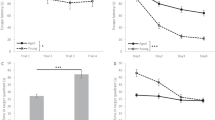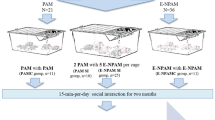Abstract
Although studies suggest that cognitive functions in the elderly are impaired, elderly people tend to be more successful and wiser in solving emotional problems. In empathy-like behavior models, the observer rat rescues the distressed cage mate by displaying emotional and cognitive ability. The aim of the study was to investigate the changes in empathy-like behavior in older rats in comparison to adult rats. In addition, we wanted to determine the effects of alterations in neurochemicals (such as corticosterone, oxytocin, vasopressin, and their receptor levels) and emotional situations on this behavior. In our study, we initially completed empathy-like behavior tests and emotional tests (open field, elevated plus maze) and performed neurochemical examinations in the serum and brain tissues. In the second step of research, we applied a midazolam (benzodiazepine) treatment to examine the effect of anxiety on empathy-like behavior. In the old rats, we observed that empathy-like behavior deteriorated, and anxiety signs were more pronounced. We detected a positive correlation between the latency in empathy-like behavior and corticosterone levels and v1b receptor levels. The midazolam effect on empathy-like behavior was attenuated by flumazenil (a benzodiazepine receptor antagonist). The recordings of ultrasonic vocalization showed frequencies around 50 kHz emitted by the observer and this was associated with the expectation of social contact. Our results state that compared to adult rats, old rats were more concerned and failed during empathy-like behavior. Midazolam may improve this behavior by anxiolysis.






Similar content being viewed by others
Data availability
The datasets generated and/or analyzed during the current study are available from the corresponding author upon reasonable request.
References
Arsenijevic Y, Dreifuss JJ, Vallet P et al (1995) Reduced binding of oxytocin in the rat brain during aging. Brain Res 698:275–279
Bailey PE, Henry JD, Von Hippel W (2008) Empathy and social functioning in late adulthood. Aging Ment Health 12:499–503
Baron-Cohen S, Wheelwright S (2004) The empathy quotient: an investigation of adults with Asperger syndrome or high functioning autism, and normal sex differences. J Autism Dev Disord 34:163–175
Barraza JA, Zak PJ (2009) Empathy toward strangers triggers oxytocin release and subsequent generosity. Ann NY Acad Sci 1167:182–189
Beadle JN, Sheehan AH, Dahlben B et al (2015) Aging, empathy, and prosociality. J Gerontol B Psychol Sci Soc Sci 70:213–222
Ben-Ami Bartal I, Shan H, Molasky NM et al (2016) Anxiolytic treatment impairs helping behavior in rats. Front Psychol 7:850
Broniarczyk-Czarniak M, Szemraj J, Śmigielski J et al (2022) The role of OXT, OXTR, AVP, and AVPR1a gene expression in the course of schizophrenia. Curr Issues Mol Biol 44:336–349
Carvalheiro J, Seara-Cardoso A, Mesquita AR et al (2019) Helping behavior in rats (Rattus norvegicus) when an escape alternative is present. J Comp Psychol 133:452–462
Cavaliere DR, Maisonnette S, Krahe TE et al (2020) High- and low-conditioned behavioral effects of midazolam in carioca high- and low-conditioned freezing rats in an ethologically based test. Neurosci Lett 715:134632
Chaouloff F, Durand M, Mormède P (1997) Anxiety- and activity-related effects of diazepam and chlordiazepoxide in the rat light/dark and dark/light tests. Behav Brain Res 85:27–35
Corbani M, Marir R, Trueba M et al (2018) Neuroanatomical distribution and function of the vasopressin V1B receptor in the rat brain deciphered using specific fluorescent ligands. Gen Comp Endocrinol 258:15–32
Davidson NB, Hurst JL (2019) Testing the potential of 50 kHz rat calls as a species-specific rat attractant. PLoS ONE 14:e0211601
Duan Y, Wei J, Geng W et al (2019) The effect of short-term use of benzodiazepines on cognitive function of major depressive disorder patients being treated with antidepressants. J Affect Disord 256:1–7
Ebner NC, Maura GM, MacDonald K et al (2013) Oxytocin and socioemotional aging: current knowledge and future trends. Front Human Neurosci 7:487
Gimpl G, Fahrenholz F (2001) The oxytocin receptor system: structure, function, and regulation. Physiol Rev 81:629–683
Glisky EL (2007) Changes in cognitive function in human aging. In: Riddle DR (ed) Brain Aging: Models, Methods, and Mechanisms (1st edn). CRC Press/Taylor & Francis, Boca Raton, p 18. https://www.ncbi.nlm.nih.gov/books/NBK3885/
Gross JJ, Carstensen LL, Pasupathi M et al (1997) Emotion and aging: experience, expression, and control. Psychol Aging 12:590–599
Hosgorler F, Koc B, Kizildag S et al (2020) Magnesium acetyl taurate prevents tissue damage and deterioration of prosocial behavior related with vasopressin levels in traumatic brain injured rats. Turk Neurosurg 30:723–733
Hühnel I, Fölster M, Werheid K et al (2014) Empathic reactions of younger and older adults: no age related decline in affective responding. J Exp Soc Psychol 50:136–143
Jung YH, Shin NY, Jang JH et al (2019) Relationships among stress, emotional intelligence, cognitive intelligence, and cytokines. Medicine 98:e15345
Kandis S, Ates M, Kizildag S et al (2018) Acetaminophen (paracetamol) affects empathy-like behavior in rats: dose-response relationship. Pharmacol Biochem Behav 175:146–151
Karakilic A, Kizildag S, Kandis S et al (2018) The effects of acute foot shock stress on empathy levels in rats. Behav Brain Res 349:31–36
Katz DA, Locke C, Greco N et al (2017) Hypothalamic-pituitary-adrenal axis and depression symptom effects of an arginine vasopressin type 1B receptor antagonist in a one-week randomized phase 1b trial. Brain Behav 7:e00628–e00628
Knight LK, Stoica T, Fogleman ND et al (2019) Convergent neural correlates of empathy and anxiety during socioemotional processing. Front Hum Neurosci 13:94. https://doi.org/10.3389/fnhum.2019.00094
Knobloch HS, Charlet A, Hoffmann LC et al (2012) Evoked axonal oxytocin release in the central amygdala attenuates fear response. Neuron 73:553–566
Kollmuss A, Agyeman J (2002) Mind the gap: why do people act environmentally and what are the barriers to pro-environmental behavior? Environ Educ Res 8:239–260
Kosfeld M, Heinrichs M, Zak PJ et al (2005) Oxytocin increases trust in humans. Nature 435:673–676
Lamm C, Batson CD, Decety J (2007) The neural substrate of human empathy: effects of perspective-taking and cognitive appraisal. J Cogn Neurosci 19:42–58
Langer K, Hagedorn B, Stock L-M et al (2020) Acute stress improves the effectivity of cognitive emotion regulation in men. Sci Rep 10:11571
Lee HJ, Macbeth AH, Pagani JH et al (2009) Oxytocin: the great facilitator of life. Prog Neurobiol 88:127–151
Lomidze N, Zhvania MG, Tizabi Y et al (2020) Age-related behavioral and ultrastructural changes in the rat amygdala. Dev Neurobiol 80:433–442
Miao Y-L, Guo W-Z, Shi W-Z et al (2014) Midazolam ameliorates the behavior deficits of a rat posttraumatic stress disorder model through dual 18 kDa translocator protein and central benzodiazepine receptor and neurosteroidogenesis. PLoS ONE 9:e101450–e101450
Olkkola KT, Ahonen J (2008) Midazolam and other benzodiazepines. In: Schüttler J, Schwilden H (eds) Modern anesthetics. Springer Berlin Heidelberg, Berlin, Heidelberg, pp 335–360
Panksepp J (2010) Chapter 6.1 - Emotional causes and consequences of social-affective vocalization. In: Brudzynski SM (ed) Handbook of behavioral neuroscience. Elsevier, London, pp 201–208. https://doi.org/10.1016/B978-0-12-374593-4.00020-6
Pisansky MT, Hanson LR, Gottesman II et al (2017) Oxytocin enhances observational fear in mice. Nat Commun 8:2102
Pitsikas N, Tarantilis PA (2020) The GABA(A)-benzodiazepine receptor antagonist flumazenil abolishes the anxiolytic effects of the active constituents of Crocus sativus L. crocins in rats. Molecules 25(23):5647. https://doi.org/10.3390/molecules25235647
Porges SW (2003) Social engagement and attachment: a phylogenetic perspective. Ann NY Acad Sci 1008:31–47
Potasiewicz A, Holuj M, Litwa E et al (2020) Social dysfunction in the neurodevelopmental model of schizophrenia in male and female rats: behavioural and biochemical studies. Neuropharmacology 170:108040
Qi C, Roseboom PH, Nanda SA et al (2010) Anxiety-related behavioral inhibition in rats: a model to examine mechanisms underlying the risk to develop stress-related psychopathology. Genes Brain Behav 9:974–984
Rodrigues-Alves PDSEB, Flório JC, Lebrun I et al (2009) Moxidectin interference on motor activity of rats %. J Braz Arch Biol Technol 52:883–891
Ruffman T, Henry JD, Livingstone V et al (2008) A meta-analytic review of emotion recognition and aging: implications for neuropsychological models of aging. Neurosci Biobeh Rev 32:863–881
Sato N, Tan L, Tate K et al (2015) Erratum to: Rats demonstrate helping behavior toward a soaked conspecific. Anim Cogn 18:1049
Shepherd JK, Grewal SS, Fletcher A et al (1994) Behavioural and pharmacological characterisation of the elevated “zero-maze” as an animal model of anxiety. Psychopharmacology 116:56–64
Shoji H, Mizoguchi K (2011) Aging-related changes in the effects of social isolation on social behavior in rats. Physiol Behav 102:58–62
Smith CJW, Poehlmann ML, Li S et al (2017) Age and sex differences in oxytocin and vasopressin V1a receptor binding densities in the rat brain: focus on the social decision-making network. Brain Struc Funct 222:981–1006
Song C, Berridge KC, Kalueff AV (2016) ‘Stressing’ rodent self-grooming for neuroscience research. Nat Rev Neurosci 17:591–591
Sotoudeh N, Namavar MR, Zarifkar A et al (2020) Age-dependent changes in the medial prefrontal cortex and medial amygdala structure, and elevated plus-maze performance in the healthy male Wistar rats. IBRO Rep 9:183–194
Steimer T (2011) Animal models of anxiety disorders in rats and mice: some conceptual issues. Dialogues Clin Neurosci 13:495–506
Thomson F, Napier S (2015) Arginine-vasopressin. In: Stolerman IP, Price LH (eds) Encyclopedia of psychopharmacology. Springer Berlin Heidelberg, Berlin, Heidelberg, pp 195–202
Uzefovsky F, Shalev I, Israel S et al (2015) Oxytocin receptor and vasopressin receptor 1a genes are respectively associated with emotional and cognitive empathy. Horm Behav 67:60–65
Xia Y, Ye S, Shi J, Huang H (2018) Relationship between the anxious symptoms and the neurotransmitter in Parkinson’s mice with different dosages of MPTP. Braz Arch Biol Technol 61:e18160721. https://doi.org/10.1590/1678-4324-2018160721
Yuksel O, Ates M, Kizildag S, Yuce Z, Koc B, Kandis S, Guvendi G, Karakilic A, Gumus H, Uysal N (2019) Regular aerobic voluntary exercise increased oxytocin in female mice: cause to decrease anxiety and increase empathy-like behaviors. Balkan Med J 36(5):257–262. https://doi.org/10.4274/balkanmedj.galenos.2019.2018.12.87
Author information
Authors and Affiliations
Contributions
Conceptualization: Ferda Hosgorler. Data curation: Ferda Hosgorler, Erhan Caner Akkaya, Rabia Ilgin, Servet Kizildag, Basar Koc. Formal analysis: Ferda Hosgorler, Erhan Caner Akkaya, Rabia Ilgin, Hikmet Gumus. Funding acquisition: Nazan Uysal. Investigation: Ferda Hosgorler, Erhan Caner Akkaya, Rabia Ilgin, Basar Koc, Servet Kizildag. Methodology: Ferda Hosgorler, Nazan Uysal. Resources: Nazan Uysal. Validation: all authors. Writing — original draft: Ferda Hosgorler. Writing — review and editing: all authors. The authors declare that all data were generated in-house and that no paper mill was used.
Corresponding author
Ethics declarations
Ethical approval
The study was approved by the Experimental Animals Ethics Committee (approval number: 05.04.2018-40/2018). The rats’ care and experimental procedures were performed by the experimental study team in accordance with the “Guide for the Care and Use of Laboratory Animals” guide.
Competing interests
The authors declare no competing interests.
Additional information
Publisher's note
Springer Nature remains neutral with regard to jurisdictional claims in published maps and institutional affiliations.
Rights and permissions
Springer Nature or its licensor (e.g. a society or other partner) holds exclusive rights to this article under a publishing agreement with the author(s) or other rightsholder(s); author self-archiving of the accepted manuscript version of this article is solely governed by the terms of such publishing agreement and applicable law.
About this article
Cite this article
Hosgorler, F., Akkaya, E.C., Ilgin, R. et al. The ameliorative effect of midazolam on empathy-like behavior in old rats. Naunyn-Schmiedeberg's Arch Pharmacol 396, 3183–3193 (2023). https://doi.org/10.1007/s00210-023-02526-1
Received:
Accepted:
Published:
Issue Date:
DOI: https://doi.org/10.1007/s00210-023-02526-1




